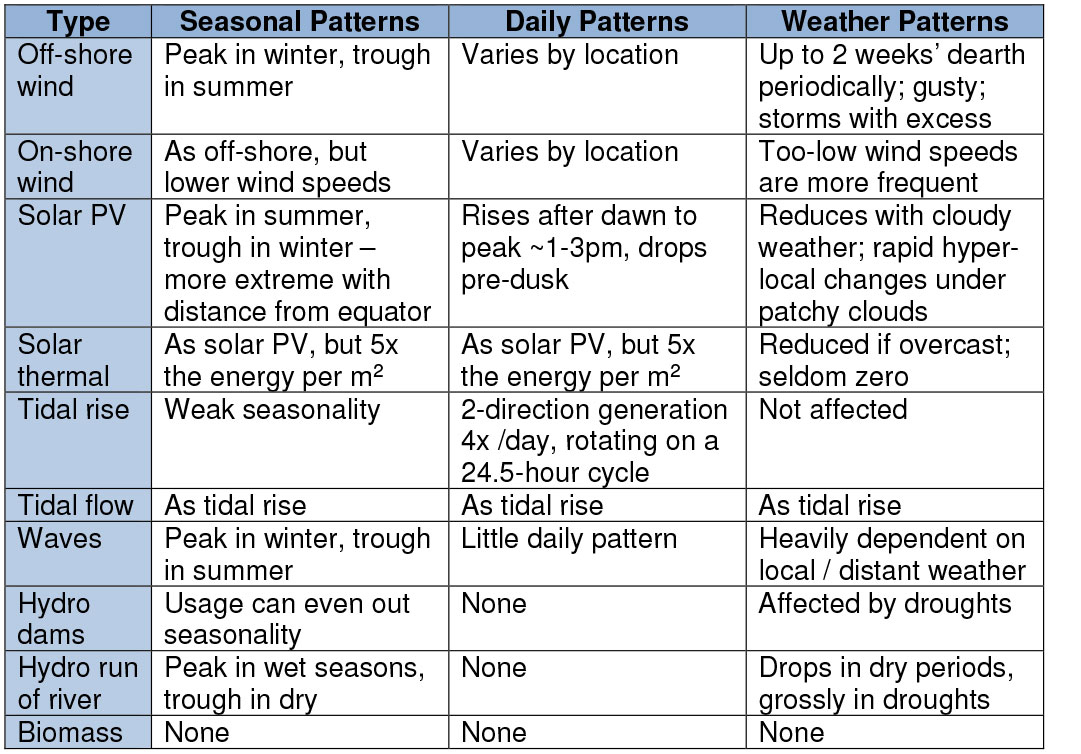What would such a system look like?
A de-carbonised energy system would be built up of many diverse elements selected to be the most suitable mix for each location. There is no single answer or “magic bullet”, no “winning technology” for powering the world, or even for providing balancing and ancillary services: the actual answer to questions of which to choose is “all of the above”.
Patterns of demand
Demand patterns vary by geographical region and by culture. Warmer climates may have greater demand in summer than in winter; temperate and colder climates reverse this. Climates where winter temperatures regularly drop too low (the limit is ~-8oC, but is being extended downwards by technological developments) can’t use heat pumps during such periods. Spain’s late-night culture (for example) pushes the evening peak much later than other countries with similar climates. Certain national and religious festivals cause peaks in demands; others (e.g. Christmas and the new year in temperate climates) cause troughs.
Patterns of supply
Every low-carbon form of generation, storage and balancing has different characteristics; these must be planned in terms of seasonal, daily and weather-related patterns. A far-too-brief comparison of generation would start with:
Sources of energy
While biomass looks the most attractive, the source of its energy is of primary concern: above a fairly low level (energy from waste), it displaces farmland in a planet in which good farmland is scarce and populations are still rising.
Hydro-electric dams also look very attractive until the disruption to fish stocks and the flooding of land is considered. Solar is, like wind, an almost unlimited source of energy; however both (solar in particular) should be careful not to displace farmland. Solar is best located on rooftops, especially large commercial rooftops like stations, conference centres, warehouses, factories etc. where well-designed installations need not displace anything that is necessary.
Patterns of demand
The selection of renewable generation should be chosen to reflect patterns of demand. Here the main issue is seasonality. For example, in temperate climates solar generation peaks in summer and troughs in winter; wind does the reverse. Therefore the correct mix of solar and wind will match (with moderate accuracy) the seasonal variation of demand. If such seasonal matching is done, then the requirement for seasonal storage is eliminated, so the total required storage becomes the amount needed to fill in for any weather-related changes – in Germany and nearby countries, this is the kalte dunkel Flaute (cold dark doldrums), a 2-week weather pattern (high pressure in winter) during which renewable generation is low or negligible across most of the continent, occurring every couple of years – or much more frequently over more restricted geographical spreads or durations.
Storage and balancing
Balancing and storage technologies are again selected on a locational basis.
Many countries (especially across the European Union) are relying on interconnectors to balance their intermittent renewable generation, importing during times of “system stress”, i.e. high demand and/or low intermittent supply. What they miss is that such times of system stress (e.g. after sunset on a windless winter evening; or a kalte dunkel Flaute) occur concurrently in neighbouring countries, begging the question: from whom can they import? Therefore, other than to the extent that they are liked to tied back-up (e.g. to pumped hydro in Norway which is contracted to serve the German market), they cannot provide the back-up required. Instead, the proper role of interconnectors is to keep prices competitive.
Back-up services (balancing and ancillary) must therefore be provided by a combination of dispatchable generation (e.g. biomass), baseload generation (e.g. nuclear), storage and DSR. These again must be a mix:
- Demand side response (DSR) is usually the most cost-effective, but the most limited: in 2015 National Grid assessed the UK’s DSR capacity at 5% of demand; the same resources cannot be used more than once in an evening, so the effective DSR capacity is between one-half and one-third of that. Its typical durations are 20-40 minutes, so it is best used for spikes (upwards or downwards) in supply and/or demand.
- Batteries (solid state, like lithium ion) are not geographically restricted, and have cost-optimal sizes of up to 50MW and durations of 30-120 minutes; they are best used for shorter-duration peaks and troughs. Vehicle-to-grid and smart-charging systems fall in this category.
- Medium-scale storage (e.g. LAES, flow batteries) are not geographically restricted and are best used for longer-duration peaks and troughs.
- Large-scale long-duration storage (e.g. pumped hydro, CAES) are necessary for the weather-related peaks and troughs. They are the cheapest and most long-lasting installations per MWh of capacity, but tend to be geographically restricted: topologically for pumped hydro, geologically for CAES.
Does nuclear have a role to play?
Nuclear is not necessary, but very helpful. It can have a major role to play in locations where it’s suitable, i.e. well governed and not susceptible to natural disasters. That role is to provide baseload electricity, while renewables plus storage provide dispatchable (i.e. on-demand) electricity. This is because 1GW of nuclear provides a similar amount of baseload electricity to ~3GW offshore wind plus storage, ~4GW onshore wind plus storage and ~8–10GW solar plus storage – all these figures depending on the actual climatic and weather situations of the locations concerned. Another consideration is energy density: wind farms generate ~30MW/km2, while nuclear generates ~5GW/km2.
Many question its safety. If properly sited (unlike Fukushima) and designed to be failsafe (like all plants built since Three Mile Island), and if properly managed and regulated (unlike Chernobyl and, to a lesser extent, Fukushima), it is safe. You receive more radiation from an hour’s walk across granite hills (e.g. Aberdeen, Dartmoor) or an hour wearing a luminous watch than by an hour’s picnic by a reactor vessel or swim across its outflow. And, including military use, it has killed fewer people ever than the coal industry kills every 2 years or so.
Regulatory consequences
It is possible for private finance / the markets to provide all of this, but only in the correct regulatory environment with appropriate contractual frameworks. Example policies include:
1. Tax emissions fully for the harm they do to the planet; figures range from $40 to $220 per tonne of CO2 equivalent, but all such figures are rising as more malign consequences of emissions are discovered and evaluated.
2. Put in place a national / regional assessment that outlines the target energy mix that would be optimal for the location, for a zero-carbon system, to act as the blue-print against which financiers and industry can justify investment.
3. Change the regulatory definition of storage from a form of generation to a grid service: it displaces energy in time much as interconnectors displace it in location.
4. Set up long-term contracts that provide the contractual certainty required for new private investment. We have proposed such a system in our document A 21st Century Energy System, which suggests that:
¨ One-third of all contracts should have 15-year durations, but only available for new build;
¨ One-third with 7.5-year durations, but only for new build or major investment;
¨ One-third with 2-year durations or less, for any, which keeps prices down;
¨ Flex the contract duration with emissions such that these durations are given for clean duration, half durations for coal, and a linear relationship between the two, to incentivise clean energy non-financially;
¨ Provide binding letters of intent for all first-of-a-kind commercial plants at both distribution and transmission scale, to buy their services at the prices that pertain at the time for 15 years, to de-risk the implementation of innovative technologies without a penny of subsidy.
5. Contract for balancing and storage services from the largest scale to the smallest:
¨ Set in place the large-scale long-duration storage; then establish which other services they can provide cost-effectively, and only contract for such other services as are not provided by these – and so on down the scale of storage / DSR;
¨ This ensures that each technology can generate its profits without subsidy because it can contract for its whole revenue stack, and cuts each plant’s financing costs;
¨ It also greatly reduces the over-construction of assets of any type or scale, thereby ensuring efficient use of resources and even lower financing costs.
Overall, such a system would not cost more than today’s energy system, if one includes overt and covert subsidies – even without accounting for the consequential damage of pollution and emissions.
Click here to download the PDF



